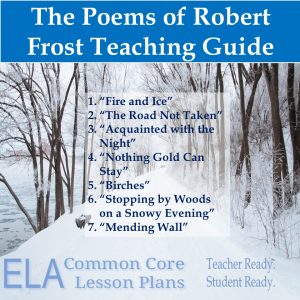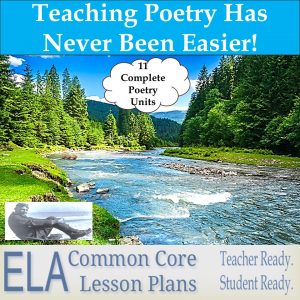Why would anybody stop in the snow and cold to stare at some trees? We’ll find out in this an analysis of “Stopping by Woods on a Snowy Evening.”
Let’s not fool around. I’ll just give you a graphic organizer that goes with the Symbolism in Robert Frost’s Poems Lesson Plans.
“Stopping by Woods on a Snowy Evening” by Robert Frost

You want to teach Frost but you’re afraid of an ice cold reception because you don’t have enough time to prepare a great lesson? No worries. These Robert Frost poetry lesson plans are ready to use.
An analysis of “Stopping by Woods on a Snowy Evening” begins with reading the poem. It’s short. Read it several times. That’s what I did. Then I followed these step-by-step instructions on how to analyze a poem. Here’s a copy of the poem to save you the trouble of doing a Google search.
Whose woods these are I think I know.
His house is in the village though;
He will not see me stopping here
To watch his woods fill up with snow.
My little horse must think it queer
To stop without a farmhouse near
Between the woods and frozen lake
The darkest evening of the year.
He gives his harness bells a shake
To ask if there is some mistake.
The only other sound’s the sweep
Of easy wind and downy flake.
The woods are lovely, dark and deep.
But I have promises to keep,
And miles to go before I sleep,
And miles to go before I sleep.
My Collection of Essay Evidence for “Stopping by Woods”

Imagine having 11 complete poetry units with handouts and lesson plans completed. You don’t need to imagine. These units are teacher ready and student ready. Just print, make copies, and accept accolades from colleagues and students.
My annotated analysis of “Stopping by Woods on a Snowy Evening” produces the following observations:
- rhyme scheme: a a b a b b c b c c d c d d d d
- meter = iambic tetrameter
- the rhyme scheme represents the ever present hand of death reaching back to get us.
- the rhyme scheme jolts the reader: we are given a couplet to open each stanza and instinctively expect a couplet to end each stanza. Instead the stanza ends with an additional line of rhyme for the couplet. It’s familiar, but not what we expect. Death, too, is familiar, but often comes unexpectedly.
- The poem takes place in the dead of winter as the speaker watches the “woods fill up with snow” (4).
- Nearby is a frozen lake (lifeless). It’s the darkest evening of the year–death.
- The horse senses something amiss and shakes his bells, knocking the speaker and the reader out of a trance.
- Line 13 – “The woods are lovely, dark, and deep.” Sounds inviting to the reader–the chance to rest eternally.
- Lines 14-16 – The speaker realizes it’s not his time to enter the woods. He has “promises to keep” (14), and “miles to go before I sleep” (16).
Paragraph Analysis of “Stopping by Woods on a Snowy Evening” by Robert Frost
In “Stopping by Woods on a Snowy Evening,” Robert Frost contemplates death. The setting symbolizes death. There’s a “frozen lake” nearby a woods filled up with snow on the “darkest evening of the year.” The speaker is enchanted with the woods, death, and stops to ponder. The rhyme scheme, with one line of rhyme present in each preceding stanza, mirrors the thought of death reaching into the speaker’s thought. Although the woods become inviting to the tired traveler, as death does for some, the speaker realizes he cannot yet stop and rest because of his “promises” (14). The last two lines seems to be a lament at what lies ahead–a long life without rest.
